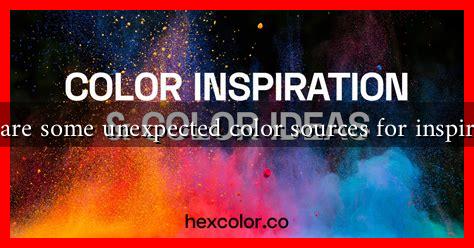-
Table of Contents
What are Some Unexpected Color Sources for Inspiration?
Color is a powerful tool in design, art, and branding, influencing emotions and perceptions. While many people draw inspiration from traditional sources like nature or art history, there are unexpected places that can spark creativity and provide unique color palettes. This article explores some of these unconventional sources, offering insights and examples to inspire your next project.
1. Urban Environments
Cities are vibrant tapestries of color, often overlooked as sources of inspiration. The interplay of architecture, street art, and urban life can yield unexpected color combinations.
- Street Art: Murals and graffiti often feature bold, contrasting colors that can inspire dynamic designs. For instance, the Wynwood Walls in Miami showcases a plethora of colors that artists use to express social messages.
- Architecture: Buildings in different styles and eras can provide a rich palette. The pastel-colored houses of Cape Town’s Bo-Kaap neighborhood are a prime example of how cultural heritage influences color choices.
- Public Spaces: Parks and plazas often incorporate colorful elements like flowers, sculptures, and benches. The High Line in New York City combines natural and man-made colors, creating a unique visual experience.
2. Food and Culinary Arts
The culinary world is a treasure trove of color inspiration. The vibrant hues of fruits, vegetables, and dishes can evoke emotions and stimulate the senses.
- Fruits and Vegetables: The rainbow of produce available at farmers’ markets can inspire fresh color palettes. For example, the deep purple of eggplants paired with the bright yellow of corn can create a striking contrast.
- Plating Techniques: Chefs often use color to enhance the visual appeal of their dishes. The art of plating can inspire designers to think about how colors interact on a surface.
- Food Photography: Instagram and food blogs showcase colorful dishes that can inspire color schemes for branding or graphic design. The trend of vibrant smoothie bowls is a perfect example of how food can influence color choices.
3. Technology and Digital Media
In the digital age, technology offers a plethora of color inspiration through various platforms and tools.
- Social Media: Platforms like Pinterest and Instagram are filled with curated color palettes. Users can explore trending colors and styles, such as the Pantone Color of the Year, which often reflects current cultural sentiments.
- Color Generators: Websites like Coolors.co allow users to create and explore color schemes based on different themes or moods, providing a digital playground for color exploration.
- Video Games: The immersive worlds of video games often feature unique color palettes that can inspire designers. Games like “Journey” and “Ori and the Blind Forest” are known for their stunning visuals and color use.
4. Cultural Artifacts and Textiles
Exploring cultural artifacts can reveal rich color histories and traditions that inform modern design.
- Textiles: Fabrics from different cultures, such as Indian saris or African kente cloth, showcase intricate patterns and vibrant colors that can inspire fashion and interior design.
- Traditional Crafts: Pottery, ceramics, and other crafts often use natural pigments that reflect the environment and culture. The blue and white pottery of Delft, Netherlands, is a classic example of how color can tell a story.
- Art Movements: Historical art movements, such as Impressionism or Fauvism, can provide insights into color theory and application. Artists like Claude Monet used color to evoke emotion and atmosphere, which can inspire contemporary creators.
Conclusion
Inspiration for color can come from the most unexpected places. By looking beyond traditional sources, such as nature and art, designers and artists can discover unique palettes that resonate with their audience. Urban environments, culinary arts, technology, and cultural artifacts all offer rich, diverse color inspirations that can enhance creativity and innovation.
As you embark on your next project, consider exploring these unconventional sources. You may find that the vibrant colors of a city street, the rich hues of a dish, or the intricate patterns of a textile can spark your imagination and lead to groundbreaking designs. Embrace the unexpected, and let your creativity flourish!
For more insights on color theory and design inspiration, visit Color Adobe.

